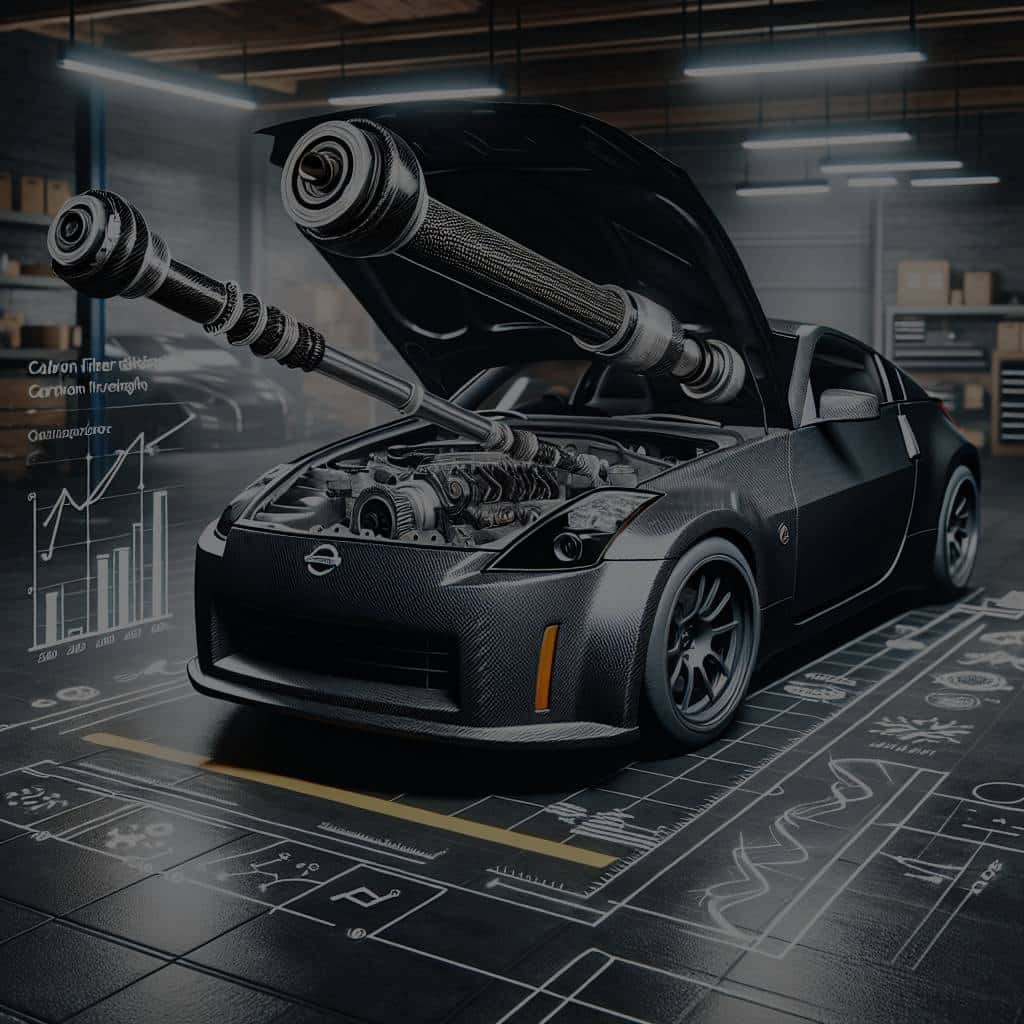If you’re an owner of a Nissan 350Z, or if you’re simply an automotive enthusiast curious about the effects of upgrading to a carbon fiber driveshaft, then this article is for you. Focused on the driveline system of the Nissan 350Z, we will delve into how the various components, from the engine to the driveshaft, interact with each other and how replacing certain parts with high-performance alternatives can influence the efficiency of the power transmission process.
The Importance of the Driveline System
The driveline system, also known as the drivetrain, is a critical component of any vehicle. It’s the mechanical system that transfers power from the engine to the wheels, enabling the vehicle to move. This system includes key components such as the engine, transmission, driveshaft, differential, and axles.
In parallel : What Are the Best Performance Mods for a Fiat Abarth 500 Competizione?
The engine is the heart of the driveline, producing the power required to propel the vehicle. It does so by burning fuel in its combustion chambers, with the resulting energy turning a crankshaft. This rotational motion is then transferred to the transmission.
The transmission acts as a mediator between the engine and the driveshaft. Depending on the vehicle’s speed and load, this intermediary component changes the engine’s output before it reaches the driveshaft, ensuring optimal performance and fuel economy.
In the same genre : How to Retrofit Modern Electronic Stability Control in Classic Muscle Cars?
The driveshaft is responsible for transmitting torque and rotation from the transmission to the vehicle’s differential, which subsequently distributes the power to the wheels. It’s a crucial link in the driveline system and its efficiency can significantly impact a vehicle’s performance.
Carbon Fiber Driveshaft: A Performance Upgrade
There are three main types of driveshafts: steel, aluminum, and carbon fiber. While steel is the most common material used due to its durability and cost-effectiveness, it is also the heaviest. Aluminum driveshafts are lighter, but they can be prone to bending under high torque loads. Carbon fiber, on the other hand, offers the best of both worlds: it’s both lightweight and incredibly strong.
A carbon fiber driveshaft is an excellent performance upgrade due to its high strength-to-weight ratio. It is lighter than a traditional steel driveshaft, reducing the overall weight of the vehicle and thus improving its power-to-weight ratio. This can enhance acceleration, fuel economy, and overall driving feel.
Moreover, a carbon fiber driveshaft also exhibits a high degree of torsional rigidity, or resistance to twisting under load. This can result in smoother power transmission, better throttle response, and less energy loss, as there is less rotational inertia to overcome.
The Impact of a Carbon Fiber Driveshaft on the Nissan 350Z
So, how does a carbon fiber driveshaft affect the driveline efficiency of a Nissan 350Z, specifically? The answer lies in its unique design and mechanical properties.
The Nissan 350Z comes equipped with a two-piece steel driveshaft. While reliable and sturdy, this design tends to be heavier and less efficient than a one-piece carbon fiber variant.
When you replace the stock driveshaft with a carbon fiber unit, you’ll likely notice an immediate improvement in acceleration and throttle response, particularly at higher speeds. This is because the lightweight carbon fiber driveshaft reduces the driveline’s rotational mass, thus allowing the engine to rev up quicker.
Moreover, due to the superior torsional rigidity of carbon fiber, power transmission becomes more efficient. The fibers in the driveshaft align with the direction of the torque, enabling it to handle greater loads without deforming. This results in a direct, positive feel when you step on the gas pedal, as more of the engine’s power is effectively transferred to the wheels.
Other Supporting Modifications
While a carbon fiber driveshaft can significantly boost driveline efficiency, it’s important to consider other modifications to fully reap its benefits. These include components such as the differential, transmission, and engine itself.
Upgrading the differential to a performance-oriented unit can help optimize power distribution to the wheels. This can enhance handling and acceleration, particularly in high-performance driving scenarios.
The transmission can also be improved, with high-performance gear ratios and shift kits offering smoother, faster gear changes. This can complement the improved throttle response of a carbon fiber driveshaft by ensuring that the power delivery is as instantaneous and seamless as possible.
Finally, tweaking the engine can maximize the power available to be sent through the driveline. This can range from minor upgrades such as high-flow air intakes and exhaust systems, to more comprehensive changes like turbocharging or supercharging.
In conclusion, while a carbon fiber driveshaft can indeed improve the driveline efficiency of a Nissan 350Z, it is just one piece of a bigger picture. It works best when paired with complementary modifications that aim to optimize each component of the driveline system.
The Role of Supporting Systems in Driveline Efficiency
The driveline system, key as it is, does not function in isolation. It is interconnected with several other systems, each contributing to the overall performance of the Nissan 350Z. Therefore, to truly maximize the benefits of a carbon fiber driveshaft, certain supportive systems should also be upgraded.
For instance, the brake system plays a crucial role in overall drive control, especially when dealing with the enhanced engine power. High-performance brake kits, which include components like pads and rotors, can improve heat dissipation and stopping power, thereby increasing safety during high-speed driving.
The intake system and the fuel system also contribute to engine performance. High-flow air intakes allow the engine to breathe better, enhancing throttle response and engine power output. Meanwhile, an upgraded fuel system, including high-performance fuel pumps and injectors, ensures that the engine receives an optimal amount of fuel for the combustion process.
In addition, suspension adjustable links arms and coilover kits can help manage the increased power and torque from the driveline. These upgrades can improve handling and stability, providing a smoother and more controlled ride.
The exhaust exterior system is another crucial component. A performance exhaust system, such as an exhaust catback, can enhance engine efficiency by reducing exhaust backpressure, thus improving power output and fuel economy.
Lastly, the system cooling is essential for maintaining optimal engine temperature, especially when the driveline is working hard. Upgraded radiators and cooling systems can help prevent engine overheating, ensuring sustained performance over long drives.
Conclusion: Maximizing Driveline Efficiency in the Nissan 350Z
In summary, a carbon fiber driveshaft can indeed improve the driveline efficiency of a Nissan 350Z, offering a noticeable boost in acceleration, throttle response, and overall driving feel. However, it is but one cog in the wheel of the car’s performance.
To truly maximize driveline efficiency, it is crucial to consider upgrading other key systems, such as the brake system, intake system, fuel system, system drivetrain, and system cooling. Upgrades like high-performance brake kits, suspension adjustable links arms, intake systems, and exhaust catback can all contribute to achieving optimal vehicle performance.
Moreover, the benefits of these supporting modifications extend beyond driveline efficiency. They can also improve car safety, handling, stability, and overall drive experience. Therefore, owners of the Nissan 350Z – or indeed any high-performance vehicle – should consider these upgrades to unlock the full potential of their machines.
So while the question of whether a carbon fiber driveshaft can improve driveline efficiency in a Nissan 350Z is answered affirmatively, it should not be viewed as a standalone solution. Instead, consider it as part of a broader strategy to enhance vehicle performance, involving several interconnected systems working harmoniously together. Only then can the Nissan 350Z truly deliver the exhilarating performance it is capable of.











